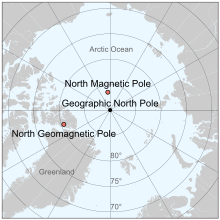magnetic north
magnetni sever
The north magnetic pole is a point on the surface of Earth's Northern Hemisphere at which the planet's magnetic field points vertically downwards (in other words, if a magnetic compass needle is allowed to rotate about a horizontal axis, it will point straight down). There is only one location where this occurs, near (but distinct from) the geographic north pole. The geomagnetic north pole, a related point, is the pole of an ideal dipole model of the Earth's magnetic field that most closely fits the Earth's actual magnetic field.
The north magnetic pole moves over time according to magnetic changes and flux lobe elongation in the Earth's outer core. In 2001, it was determined by the Geological Survey of Canada to lie west of Ellesmere Island in northern Canada at 81°18′N 110°48′W / 81.300°N 110.800°W. It was situated at 83°06′N 117°48′W / 83.100°N 117.800°W in 2005. In 2009, while still situated within the Canadian Arctic at 84°54′N 131°00′W / 84.900°N 131.000°W, it was moving toward Russia at between 55 and 60 km (34 and 37 mi) per year. As of 2019, the pole is projected to have moved beyond the Canadian Arctic to 86°26′52.8″N 175°20′45.06″E / 86.448000°N 175.3458500°E.
Its southern hemisphere counterpart is the south magnetic pole. Since Earth's magnetic field is not exactly symmetrical, the north and south magnetic poles are not antipodal, meaning that a straight line drawn from one to the other does not pass through the geometric center of Earth.
Earth's north and south magnetic poles are also known as magnetic dip poles, with reference to the vertical "dip" of the magnetic field lines at those points.



